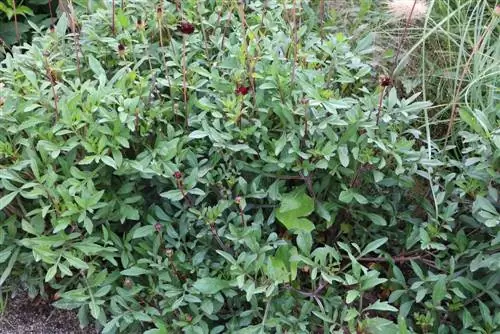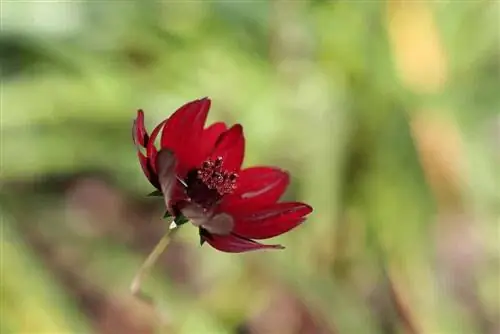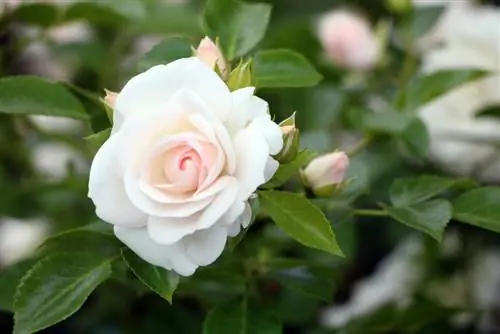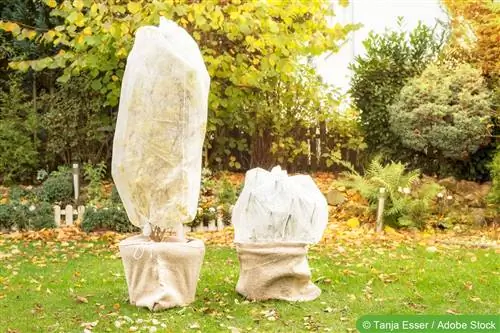- Author admin [email protected].
- Public 2023-12-17 03:39.
- Last modified 2025-01-24 12:45.
Cut in the bed, on the balcony or for the vase, they are a decorative addition. With a little care they come into full bloom including rebloom.
Chocolate flower location
The summer flower from Mexico feels particularly comfortable in a place in the sun. And the sunnier the place, the stronger the characteristic chocolate scent develops. But the flower also thrives in partial shade with some light during its growing season between May and September. This makes chocolate flowers just as imaginable in the flower bed as in the flower pot on the balcony, where they exude their scent. Specialist retailers have special potting soil available for pot planting, which is very useful here. Several layers of soil and drainage make it even easier for the chocolate flowers in the pot:
- a layer of coarse gravel at the bottom,
- non-rotting fleece on top (no silting up),
- then compost soil and peat in a ratio of 1:1
- on the top layer of soil, bark mulch to round off the look
Yellow flowers attract butterflies, bees and bumblebees, which means the bed is richly pollinated - this can be taken into account when putting together the garden. The flowers, which are related to asters, place little demands on the soil. The main thing is that it is loose and easily permeable for the roots. However, soils rich in humus and lime favor development.
Caring for the fragrant daisy family

Chocolate flowers prove that beautiful, fragrant plants don't have to be complicated. Cosmos atrosanguineus requires normal watering behavior according to the motto “less is more”, because the flower is very sensitive to waterlogging. If kept in a container, a moisture meter should be attached or at least a finger should be regularly inserted into the soil. If the soil is very wet, it is better to repot the flower than risk rot.
Dried flowers should be pinched off regularly. A conscious pruning brings about a second bloom after the first splendor. This can be done before it wilts, because the chocolate flower is ideal as a cut flower. Even in the vase it still gives off its chocolate-like aroma. If the flowers shoot up, the stems can also be tied together and stabilized with a stick.
Fertilizing the chocolate flower
Regular fertilization is not necessary for chocolate flowers, even in pots. In order to give the flowers a “kick start”, a slow-release fertilizer can be applied after application.
Pests and their control
In addition to waterlogging, some pests can also harm the chocolate flower. The nightmare of passionate gardeners are fungi and viruses. Well, asters or aster-like flowers, like the chocolate flower, run the risk of contracting fungi like Fusarium. This clogs the vessels after penetrating through the roots. The result: Initially, leaves turn yellow and fall off. Shoots gradually dry up.
A good prevention against many fungi is a calcareous soil. If it is too late, the stand may need to be cleared. In garden beds, chocolate flowers or asters may only be grown again after about 6 years.

Other enemies are powdery mildew and soft skin mites. The damage caused by powdery mildew develops as follows:
- white, mealy spots on the upper side of the leaves,
- later closed flour coating and
- Browning and dying of leaves
Lecithin-containing agents are used to combat this. Unfortunately, the effort is often not worth it. If “crippled” leaves grow at the tips of the shoots, the soft skin mite was most likely at work. The tiny animals are actually not visible. Small infestations are not a big deal. If the occurrence is massive, special preparations based on vegetable oil or potassium soap should be used.
Overwintering or propagating the chocolate flower
The flower from Mexico and exotic parts of America is an eye-catcher, but unfortunately not a winter-hardy one. In light and warmth it develops its full radiance; in winter it would actually die off. And actually the chocolate flower is generally an annual plant. But lovers can keep their plant. The secret lies underground. Because over the summer the flowers form strong tubers that can be compared to those of dahlias.
Before frost, leaves and flowers should be cut off just above the ground. The tuber can then be carefully dug up with a digging fork or a shovel. This must be done carefully so that the tuber is not injured. That would endanger overwintering. Once the juicy treasure is in your hand, the loose soil can be shaken off. It is advisable to let the tubers dry slightly.
A cool but frost-free room is required for overwintering. Basements and closed garages are the most common solutions. Stored in a flower pot, the tubers survive the winter undamaged. Only after the very last nightly frosts should the tubers be removed from their winter quarters and brought into the beds. The time has already come in February. Usually between March and April. If you find this very time-consuming, you can always skip overwintering and use new seeds in the spring.
What you should know about the chocolate flower in brief

With the chocolate flower, hobby gardeners get a sweet flower - in the truest sense. Children and adults alike will love the scent. Lots of sun, at least partial shade, and well-drained soil are the few basic requirements. Only lightly fertilized in advance. Cutting flowers really doesn't require much skill. Overwintering the summer flower, which is not winter-proof, is a bit tricky. If you don't want to go through the work, you can grow the plant from seed every year. They bloom reliably in the first year.
- The flowering period extends from June to October. Chocolate flowers, like dahlias, are ideal as cut flowers.
- The ideal location for the chocolate flower is sun and partial shade.
- The yellow flowers of the Berlandiera lyriata variety are a pasture for bumblebees and bees.
- The yellow-flowered variety smells more strongly of chocolate than the red-flowered Cosmos atrosanguineus.
- Chocolate flowers are very undemanding when it comes to care. If you regularly cut off spent flowers, you encourage re-blooming.
- The plant is suitable for fragrant patio pots and balcony boxes, but it is also an enrichment for the herb garden.
- It is best to use good potting soil for container cultivation. A permeable soil is sufficient in the garden.
- Seeds, tubers and young plants are available not only from nurseries, but also from many mail-order nurseries.






